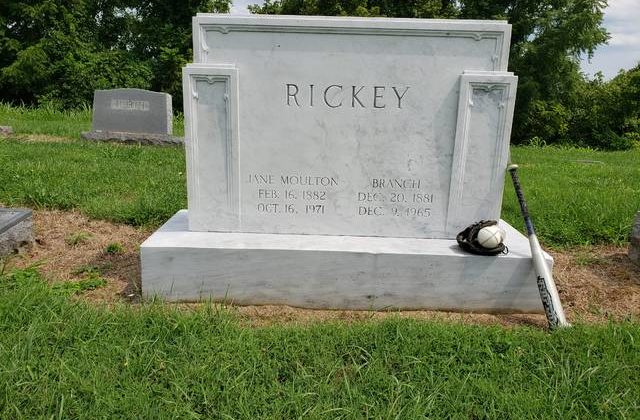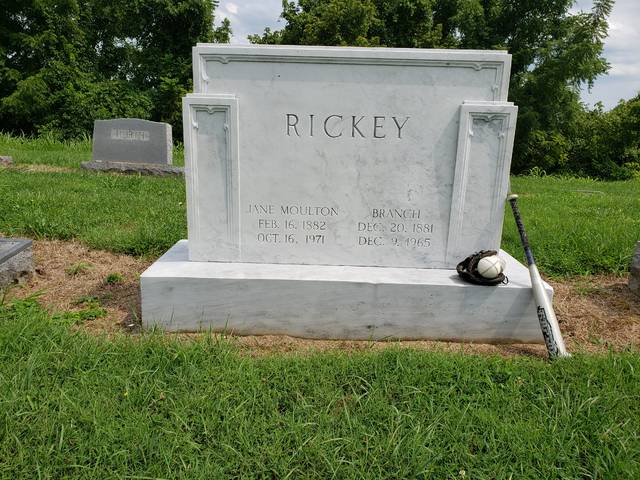
Remembering the many interesting people who rest here
Story and photos by Jane Beathard

They are presidents, pioneers, stand-out athletes, decorated war heroes, show-biz celebrities, inventors and titans of American industry. And they all have one thing in common.
Ohio is their final resting place.
Some were famous, some infamous and some barely known to the average Ohioan. Their graves are marked both by simple headstones and grand mausoleums. Some are interred in small town plots, while others rest in historic and treasured cemeteries like Lake View in Cleveland and Spring Grove in Cincinnati.
According to findagrave.com, 1,543 notable men and women (not all were Ohio natives) are buried in the Buckeye State.
Among the infamous are William Quantrill, who led a Confederate raid on the town of Lawrence, Kansas in 1863 that killed 150 residents — all Union sympathizers. Other raid participants included future outlaws Cole Younger and Jesse James. Quantrill’s Raid has been the fodder for numerous western TV shows and movies over the years. Quantrill is buried in Dover.
Another is Dr. Sam Shepherd, who was convicted of killing his wife in a 1954 trial that captivated the country for months. Shepherd, a wealthy physician who always protested his innocence, lies in Mayfield Heights.
Lesser known bad guys include John Dillinger gang member Charles Makley who is buried in Leipsic and Donald “Cinque” DeFreeze, kidnapper of newspaper heiress Patty Hearst. DeFreeze is buried in Highland Park Cemetery in Cuyahoga County.
Grade school history teaches that eight U.S. presidents came from Ohio, but only five are buried in the Buckeye State. Those five are Rutherford B. Hayes, James A. Garfield, William McKinley, Warren G. Harding and William Henry Harrison.
Harrison hailed from Virginia but is claimed by Ohio and buried in North Bend, near Cincinnati.
Ulysses S. Grant, born in Point Pleasant, is buried in New York City. William H. Taft, who was born in Cincinnati, lies in Arlington National Cemetery and Benjamin Harrison, who hailed from North Bend, is buried in Indianapolis.
By coincidence or some genetic quirk, Ohio has produced and claimed dozens of great baseball players over the years. Among them were pitching legend Cy Young, buried in Peoli, and Branch Rickey, who broke baseball’s color barrier by signing Jackie Robinson. Rickey is resting in Rush Township Memorial Park near Rushtown.
And there are literally dozens and dozens of Civil War heroes interred across the state, including Jacob Parrott the very first Medal of Honor winner.
Parrott and 22 other Ohio soldiers participated in a daring raid behind Confederate lines in 1863 aimed at capturing a train and destroying railroad tracks and bridges between Atlanta and Chattanooga. Their exploits were immortalized on film in Disney’s “Great Locomotive Chase.” Parrott is buried in Kenton.
Another, less-publicized Medal of Honor recipient was Rufus D. Hutchinson, who earned his decoration treating the wounded during Custer’s Last Stand in 1876. His final resting place is not on Montana’s Little Big Horn River, but in Butlerville.
Leaders of America’s Industrial Revolution of the late 1800s rest easily on their laurels in some of the most fashionable “marble orchards.” John D. Rockefeller Sr., the founder of Standard Oil, is in Cleveland’s Lake View Cemetery. Nearby is the mausoleum of Jeptha Wade Sr., who started Western Union, the telegraph that revolutionized communication across the U.S. in the 1860s.
Other more obscure (but no less important) inventors are John H. Balsley, father of the folding stepladder. Balsley is buried in Dayton’s Woodland Cemetery. Then, there’s Clarence A. Crane, who conceived the first Life-Saver candy. Crane is in Garrettsville.
Other figures that contributed in good or bad ways to the state’s and nation’s history and are interred in Ohio:
• Eliot Ness — ashes scattered in Lake View Cemetery, Cleveland
Famous FBI agent who brought Al Capone to justice. He created a special unit of fellow agents for the job, dubbed “The Untouchables.” Their exploits have lived on in movies and TV.
Prohibition ended Ness’ gangster-chasing days and he eventually became public safety director in Cleveland. But his career in Ohio went on the skids and he resigned after being involved in a highly publicized drunk-driving accident. He died in 1957.
• Jimmy “The Greek” Snyder — Union Cemetery, Steubenville
Easily the world’s best-known bookie. Snyder moved from his native Steubenville to Las Vegas (where gambling was and is legal) in 1956 and began hosting a TV football betting show. His reputation flourished and he eventually moved to CBS as a football color commentator.
However, he was fired by the network in 1989 after voicing a racially insensitive comment about the naturally superior athletic ability of African-Americans. He died in 1996.
• Lewis Frederick Urry — Butternut Ridge Cemetery, Lorain
Invented the alkaline battery. But more importantly to anyone with a cell phone, Urry also held the patent on the lithium battery. Lithium batteries are used in most cell phones and cameras today. He died in 2004.
• Dr. Robert “Bob” H. Smith — Mt. Peace Cemetery, Akron
A co-founder of Alcoholics Anonymous. Smith was expelled from the University of Michigan Medical School for drinking and later earned his medical degree from Rush University.
He struggled with alcoholism until 1935 when he met Bill Wilson and the two started a self-help abstinence program based on the teachings of the Oxford Group — a poplar Christian philosophy of the day which taught fear and selfishness were at the root of personal problems. He died in 1950.
• Carolyn Keene — Toledo Memorial Park
Conceived of teenage detective Nancy Drew and wrote the first 23 books about Drew’s investigative exploits. Keene also authored the Penny Parker series of books.
A veteran reporter who wrote the teen thrillers in her off time, Keene worked at the Toledo Blade newspaper until the day she died at age 96. That was in 2002.
• Dr. Henry Heimlich — Spring Grove Cemetery, Cincinnati
A thoracic surgeon who invented the Heimlich Maneuver in 1974 to relieve choking. He also invented other important healthcare devices like the Micro Trach Portable Oxygen and the Heimlich Chest Drain Valve. He died in 2016.
• Alan Freed — Lake View Cemetery, Cleveland
First coined the phrase “rock and roll” while working as a disc jockey in Cleveland. And while emceeing a show at WXEL, he used the term to describe the new type of rhythm and blues music that was growing in popularity throughout the country. The phrase caught on, and that is one reason the Rock & Roll Hall of Fame is in Cleveland today.
Freed was caught up in the 1959 “payola” scandal that revealed he was paid to play certain songs on air. Freed could not find a job after that. He died in 1965 and his grave is marked with a replica jukebox.
• Annie Oakley — ashes buried in Brock Cemetery, Greenville
Legendary sharpshooter was born Phoebe Ann Mosey in Darke County in 1860. Her father taught her to handle a gun at an early age. When she was 17, Mosey defeated nationally known marksman Frank Butler during a contest in the Cincinnati suburb of Oakley.
She eventually married Butler and the two toured the country with Buffalo Bill’s Wild West Show. Their romance became the subject of the musical “Annie Get Your Gun.”
Mosey also was an early activist for women’s rights and at one time was the best-known cultural icon in America. She died in 1926.
• Rosa “Aunt Jemima” Washington Riles — Red Oak Presbyterian Cemetery, Brown County
The third in a succession of African-American women who personified Quaker Oats’ pancake mix and syrup. Riles’ picture appeared on labels and she toured the country, making personal appearances on behalf of the company in the 1930s and 40s.
Her face modernized the original antebellum image of Aunt Jemima. Many now dismiss that image as an ugly stereotype and throwback to slavery. Riles died in 1969.
• Hector Boiardi — All Souls Cemetery, Chardon
The real Chef Boyardee. Boiardi was born in Italy and emigrated to New York in 1915 where he became a celebrity chef known for his Italian dishes. Legend has it that he even catered President Woodrow Wilson’s second wedding reception.
Boiardi moved to Cleveland in 1920 and began selling canned spaghetti sauce and similar products. Those cans became a diet staple for American soldiers in World War II and Boiardi’s reputation grew even bigger. He sold his company to American Home Foods after the war and retired. He died in 1985.
• Balto The Wonder Dog — Preserved and Mounted, Cleveland Museum of Natural History
Saved the children of Nome, Alaska during a 1925 diphtheria epidemic. Balto was the lead of a dog sled team that was one of several teams assigned to transport a life-saving anti-toxin to Nome from Nenana, Alaska.
His team was the second to last in the relay. But a blizzard prevented musher Gunnar Kaasen from finding the hand-off point to the last team.
With Balto in the lead, Kassen pushed on to Nome and delivered the serum himself. The dogs became heroes and toured the country for several years after their famous run.
A Cleveland businessman later found Balto and the other dogs living in ill-kept conditions in California. Cleveland residents then raised money to buy them and bring them to the city’s zoo. Balto died in 1933.
ID, 'source', true); $sourcelink = get_post_meta($post->ID, 'sourcelink', true); $sourcestring = '' . __('SOURCE','gabfire') . ''; if ($sourcelink != '') { echo "
$sourcestring: $source
"; } elseif ($source != '') { echo "$sourcestring: $source
"; } // Display pagination $args = array( 'before' => '' . __('Pages:','gabfire'), 'after' => '
', 'link_before' => '', 'link_after' => '', 'next_or_number' => 'number', 'nextpagelink' => __('Next page', 'gabfire'), 'previouspagelink' => __('Previous page', 'gabfire'), 'pagelink' => '%', 'echo' => 1 ); wp_link_pages($args); // Display edit post link to site admin edit_post_link(__('Edit','gabfire'),'','
'); // Post Widget gab_dynamic_sidebar('PostWidget'); ?>